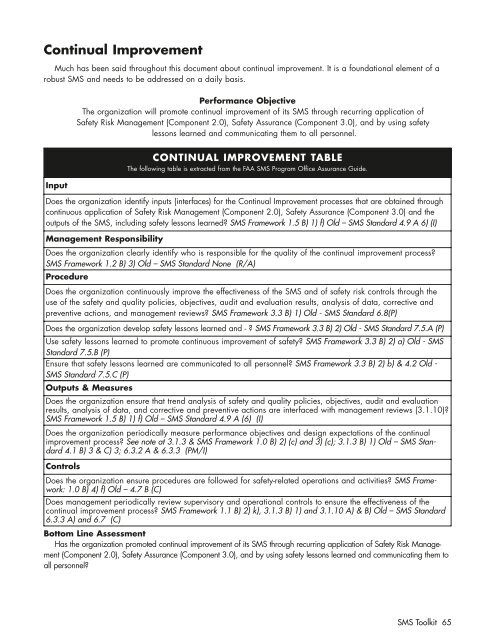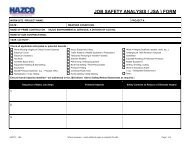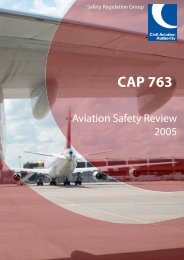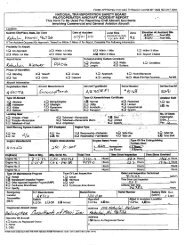International Helicopter Safety Team Safety Management System Toolkit
IHST - Safety Management Toolkit - Skybrary
IHST - Safety Management Toolkit - Skybrary
- No tags were found...
You also want an ePaper? Increase the reach of your titles
YUMPU automatically turns print PDFs into web optimized ePapers that Google loves.
Continual Improvement<br />
Much has been said throughout this document about continual improvement. It is a foundational element of a<br />
robust SMS and needs to be addressed on a daily basis.<br />
Performance Objective<br />
The organization will promote continual improvement of its SMS through recurring application of<br />
<strong>Safety</strong> Risk <strong>Management</strong> (Component 2.0), <strong>Safety</strong> Assurance (Component 3.0), and by using safety<br />
lessons learned and communicating them to all personnel.<br />
Input<br />
CONTINUAL IMPROVEMENT TABLE<br />
The following table is extracted from the FAA SMS Program Office Assurance Guide.<br />
Does the organization identify inputs (interfaces) for the Continual Improvement processes that are obtained through<br />
continuous application of <strong>Safety</strong> Risk <strong>Management</strong> (Component 2.0), <strong>Safety</strong> Assurance (Component 3.0) and the<br />
outputs of the SMS, including safety lessons learned? SMS Framework 1.5 B) 1) f) Old – SMS Standard 4.9 A 6) (I)<br />
<strong>Management</strong> Responsibility<br />
Does the organization clearly identify who is responsible for the quality of the continual improvement process?<br />
SMS Framework 1.2 B) 3) Old – SMS Standard None (R/A)<br />
Procedure<br />
Does the organization continuously improve the effectiveness of the SMS and of safety risk controls through the<br />
use of the safety and quality policies, objectives, audit and evaluation results, analysis of data, corrective and<br />
preventive actions, and management reviews? SMS Framework 3.3 B) 1) Old - SMS Standard 6.8(P)<br />
Does the organization develop safety lessons learned and - ? SMS Framework 3.3 B) 2) Old - SMS Standard 7.5.A (P)<br />
Use safety lessons learned to promote continuous improvement of safety? SMS Framework 3.3 B) 2) a) Old - SMS<br />
Standard 7.5.B (P)<br />
Ensure that safety lessons learned are communicated to all personnel? SMS Framework 3.3 B) 2) b) & 4.2 Old -<br />
SMS Standard 7.5.C (P)<br />
Outputs & Measures<br />
Does the organization ensure that trend analysis of safety and quality policies, objectives, audit and evaluation<br />
results, analysis of data, and corrective and preventive actions are interfaced with management reviews (3.1.10)?<br />
SMS Framework 1.5 B) 1) f) Old – SMS Standard 4.9 A (6) (I)<br />
Does the organization periodically measure performance objectives and design expectations of the continual<br />
improvement process? See note at 3.1.3 & SMS Framework 1.0 B) 2) (c) and 3) (c); 3.1.3 B) 1) Old – SMS Standard<br />
4.1 B) 3 & C) 3; 6.3.2 A & 6.3.3 (PM/I)<br />
Controls<br />
Does the organization ensure procedures are followed for safety-related operations and activities? SMS Framework:<br />
1.0 B) 4) f) Old – 4.7 B (C)<br />
Does management periodically review supervisory and operational controls to ensure the effectiveness of the<br />
continual improvement process? SMS Framework 1.1 B) 2) k), 3.1.3 B) 1) and 3.1.10 A) & B) Old – SMS Standard<br />
6.3.3 A) and 6.7 (C)<br />
Bottom Line Assessment<br />
Has the organization promoted continual improvement of its SMS through recurring application of <strong>Safety</strong> Risk <strong>Management</strong><br />
(Component 2.0), <strong>Safety</strong> Assurance (Component 3.0), and by using safety lessons learned and communicating them to<br />
all personnel?<br />
SMS <strong>Toolkit</strong> 65







